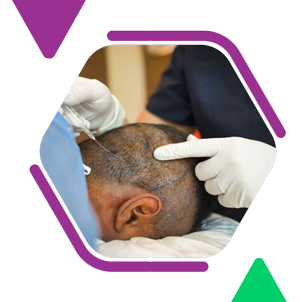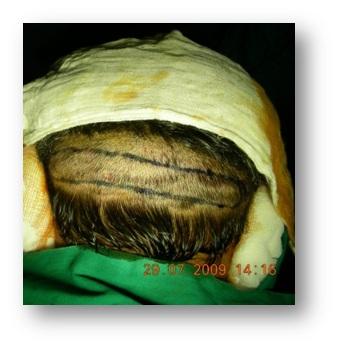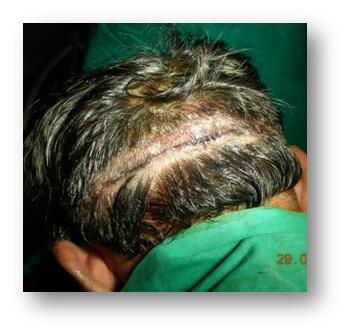- Home
- About Us
- Hair Treatment
- Hair Transplant
- Hair Loss
- Causes of Hair Loss
- Clinical Features
- Laboratory Test
- Medical Treatment
- Cyclic Treatment
- PRP
- Laser Treatment
- Surgical Treatment
- FUE
- Robotic
- FUT
- Beard Reconstruction
- Moustache Reconstruction
- Eyebrow Reconstruction
- Side Burn Reconstruction
- Complications Of Hair Transplant
- Alopecia Areata
- Telogen Effluvium
- Cosmetic Surgery
- Plastic Surgery
- Gallery
- Blogs
- Contact Us

Follicular Unit Transplantation (FUT), also known as the strip method, is a traditional yet effective hair transplant technique preferred for its ability to harvest a substantial number of grafts in a single session. Unlike Follicular Unit Extraction (FUE), which involves extracting individual follicular units directly from the scalp, FUT begins with the surgical removal of a strip of scalp tissue from the donor area. This donor strip, typically taken from the back or sides of the scalp where hair is genetically resistant to balding, is then meticulously dissected into individual follicular units for transplantation.
Step 1: Donor Harvesting
Objective of Donor Harvesting
The primary goal of donor harvesting in FUT is to remove a strip of scalp tissue from the permanent donor area in such a way that minimizes damage to the hair follicles and results in minimal, potentially undetectable scarring. This step is critical to ensure the success of the transplant and the aesthetic outcome.
Process of Donor Harvesting
The surgeon identifies the permanent donor area, typically the mid-portion of the scalp at the back or sides. A strip of scalp, approximately 1-2 cm wide and 20-25 cm in length, is carefully removed. Precision is essential to avoid transecting hair follicles, which could compromise graft viability.

Trichophytic Closure
After removing the strip, the donor site is closed using trichophytic closure. This method involves overlapping the wound edges to allow hair to grow through the scar, making it less noticeable and enhancing aesthetic outcomes.
Considerations for Donor Harvesting
– Permanent Fringe Area: It is crucial to stay within the permanent fringe area during donor strip removal to ensure long-term hair retention.
– Scalp Laxity: Patients with tight or inelastic scalps may not be suitable candidates for FUT due to increased tension on the wound site, potentially affecting scar healing.

Step 2: Graft Preparation
Conversion of Donor Tissue
The harvested strip of donor tissue undergoes meticulous processing:
– Slivering: The strip is cut into thin slices, or slivers, each containing a single row of hair follicles, under magnification to preserve follicle integrity.
– Dissection of Follicular Units: Individual follicular units containing 1-4 hair follicles are carefully dissected from the slivers. These grafts are then stored in a chilled solution to maintain viability until transplantation.
Step 3: Creating Recipient Sites
Conversion of Donor Tissue
The harvested strip of donor tissue undergoes meticulous processing:
– Slivering: The strip is cut into thin slices, or slivers, each containing a single row of hair follicles, under magnification to preserve follicle integrity.
– Dissection of Follicular Units: Individual follicular units containing 1-4 hair follicles are carefully dissected from the slivers. These grafts are then stored in a chilled solution to maintain viability until transplantation.
Step4: Placing Grafts:
The Art of Graft Placement
Graft placement is a delicate process crucial for successful outcomes:
– Tools and Techniques: Fine-tipped jeweler’s forceps are used for precise placement of grafts into recipient sites. Loop magnification aids visibility, minimizing the risk of follicle damage.
Advantages of FUT
Despite its invasiveness, FUT offers several advantages:
– Higher Graft Yield: Ideal for patients needing extensive hair coverage.
– Utilization of Stable Donor Area: Ensures long-term hair retention.
– Cost-Effectiveness: Generally more economical than FUE for large graft requirements.
Disadvantages of FUT
However, FUT has drawbacks:
– Linear Scar: Scar visibility, despite trichophytic closure, may concern some patients.
– Longer Recovery: Requires more post-operative care due to the larger incision and sutures.
– Scalp Laxity Requirement: Unsuitable for patients with tight scalps.
Post-Procedure and Hair Growth
Immediate Post-Procedure Care
Patients may experience swelling and discomfort, managed with medications and proper care instructions.
Hair Growth Timeline
Hair growth begins within months post-procedure, with final results visible within 12-18 months as transplanted hair blends naturally with existing hair.
Follicular Unit Transplantation (FUT) remains a valuable option for hair restoration, particularly for those requiring a large number of grafts. At Saundarya City, we specialize in FUT procedures, ensuring meticulous care and optimal outcomes. Consult our experienced surgeons to explore if FUT is right for you and embark on your journey to restore both hair and confidence effectively.
Our Services
- Hair Loss
- Causes of Hair Loss
- Clinical Features
- Laboratory Test
- Medical Treatment
- Cyclic Treatment
- PRP
- Hair Transplant
- Surgical Treatment
- FUE
- FUT
- Beard Reconstruction
- Moustache Reconstruction
- Eyebrow Reconstruction
- Side Burn Reconstruction
- Complications of Hair Transplant
- Alopecia Areata
- Telogen Effluvium
- Laser Treatment



 Book an Appointment
Book an Appointment